Fashion
-
As seen in: Madonna in Vogue with Pearls
As seen in: Madonna in Vogue with Pearls
Starring on the front cover of British Vogue's June 2019 issue, released on 10th May, the legendary music and cultural icon Madonna shows that pearls are still very much in vogue.
The shoot for the magazine was unveiled by the Edward Enniful OBE, the editor-in-chief of British Vogue. The story celebrates Madonna's 60th birthday and the unveiling of her new 14th album 'Madame X'.
The feature creates a series of images influenced by leading feminists of the mid-20th century "whose legacy Madonna not only admires, but relates to,” states Enniful. "I believe it’s important that we pay a little respect: for much of her life, she was probably the most high-profile feminist on the planet,” he continues. The feature celebrates the fact that, during her 20 year career, Madonna has always been a creative innovator.
The shoot was styled by Benjamin Bruno and photographed in London in March 2019 by Mert Alas and Marcus Piggott. Two of the images see Madonna styled with pearls - one in an open necked Armani white men's shirt.
We are truly delighted and honoured that our Opera Length Akoya Pearl Necklace in Yellow Gold was chosen to be worn and photographed for the stunning set of imagery.

Image: Winterson Opera Length Akoya Pearl Necklace
The necklace features a 90cm length of Akoya pearls, a classic type of saltwater pearl that is traditionally cultured in Japanese coastal waters. The Akoya pearl is loved for its sharp lustre, round shape and white colour, with a hint of pink.
A big thank you to Edward Enniful and everyone at British Vogue! -
Christian Dior: Designer of Dreams at the V&A
Christian Dior: Designer of Dreams at the V&A
Christian Dior: Designer of Dreams is the V&A's latest blockbuster exhibition to focus on the social and cultural power of clothing - from the savage beauty of Alexander McQueen to the iconography of Frida Khalo, and now, Christian Dior’s enduring juxtaposition of fantasy and functionalism, softness and tailoring that has kept fashion lovers in thrall to his brand for over 70 years.
Based on the original exhibition curated by Olivier Gabet and Florence Müllerat Le Musee des Arts Decoratifs, Paris, the V&A show has additional material selected by the V&A’s senior fashion curator Oriole Cullen. Dior in Britain, a section especially created for the London show, celebrates Monsieur Dior’s relationship to the city, its craft ateliers and the celebrated women who became his clients.
”Dior admired the grandeur of the great houses and gardens of Britain, as well as British-designed ocean liners, including the Queen Mary," Cullen explains. This unique selection of work includes a series of collaborative pieces designed by Dior but created by British craft houses such as Dents. It culminates in a beautiful Dior gown worn by Princess Margaret on her 21st birthday

Image: Princess Margaret, wearing Dior for her 21st birthday
"In 1947, Christian Dior changed the face of fashion with his New Look,” said Cullen,“which redefined the female silhouette and reinvigorated the post-war Parisian fashion industry.” Tragically Monsieur Dior himself was only at the helm of his eponymous brand for a decade before his sudden and unexpected death in Italy.
It is testament to the strength of his vision that the designers who followed in his footsteps were each, in their own way, able to evolve the label, whilst ensuring that the core elements of Dior’s world remained constant - although each of these visionary creatives emphasised differing qualities of Dior’s voice. The exhibition is organized around these themes, from the Garden to the Ballroom.

Image 1: 30 Avenue Montaigne, Paris, circa 1947
Image 2: Christian Dior with model Lucky, circa 1955
"The influence of Christian Dior's design was all-pervasive and helped to define an era. In their own individual ways, each of the house's successive artistic directors has referenced and reinterpreted Dior's own designs and continued the legacy of the founder ensuring that the house of Christian Dior is at the forefront of fashion today," Cullen suggests.
Whilst the universe John Galliano created under the banner of Dior was one of the brand’s most recognised eras, the exhibition makes clear the strength of both Raf Simons’ and Maria Grazia Chiuri’s visions for the house. In their own ways, each of the two most recent artistic directors have been able to capture and distill Dior’s magical combination of the fantastical with the wearable, whilst remaining true to the energy and direction of their times.
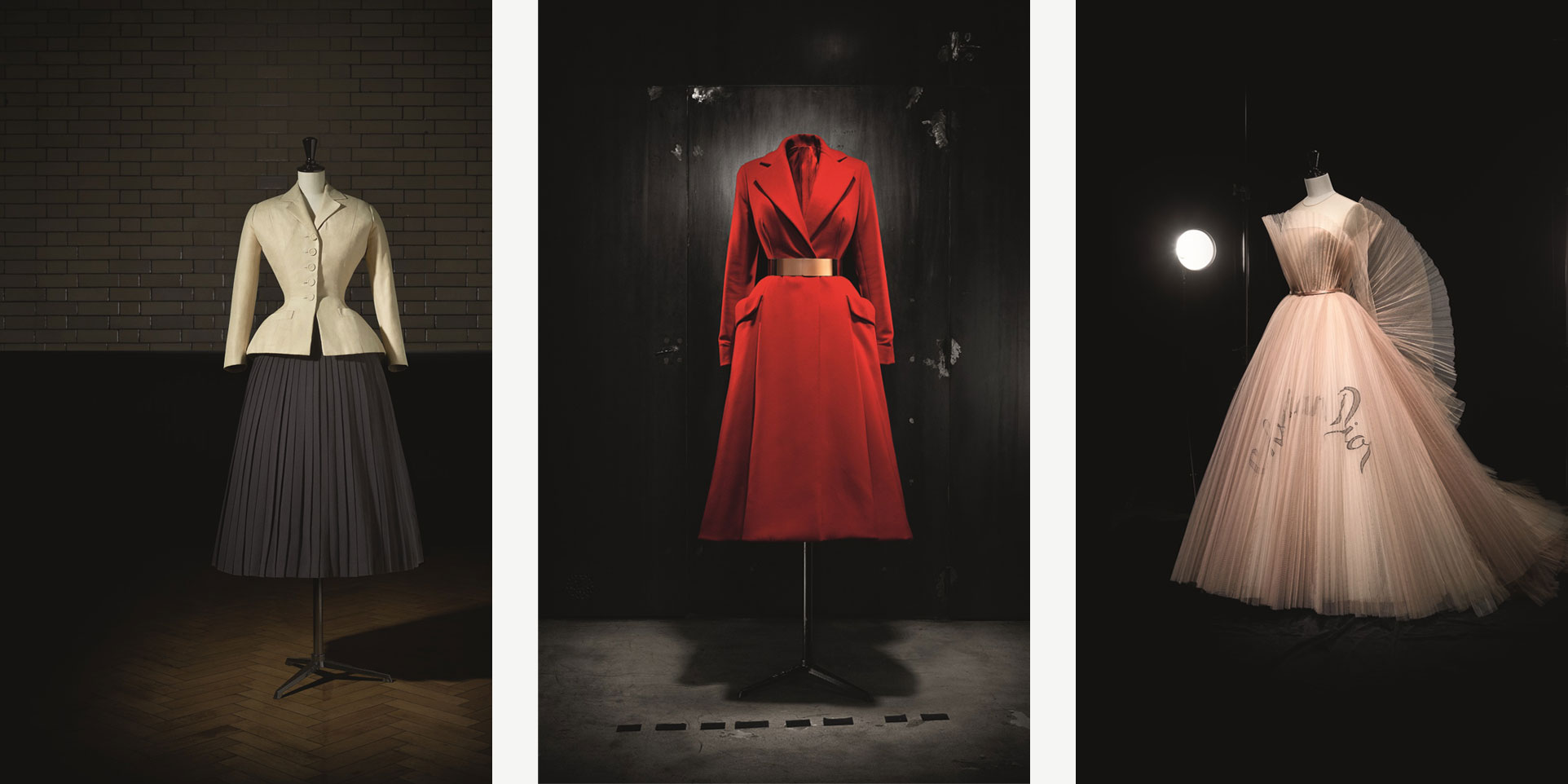
Image 1: Bar Suit by Christian Dior, 1947
Image 2: Coat, 2012 by Raf Simons
Image 2: Dress, 2018, by Maria Grazia Chiuri
If anything else, the exhibition emphasises how hard it is to design legendary, epoch defining clothes. Whilst there are some genuinely stunning garments in the show, it is hard to come away from it without thinking that, with the exception of the recently revived Galliano designed Dior Saddle bag, the New Look was by far the label’s most globally recognised silhouette.
For all this, Dior: Designer of Dreams is a feast for both fashion connoisseurs and interested observers, the quality of workmanship rightly celebrated throughout the exhibition, and a reminder of why Dior has reigned supreme over the world of fashion since 1947.
Christian Dior: Designer of Dreams is at the V&A from 2 February - 1 September 2019. -
What are the classic jewellery designs for pearls?
What are the classic jewellery designs for pearls?
It has long been known that the pearl has played a central role in jewellery, with some of the earliest recorded fragments of a pearl necklace being dated to the 4th century BC. What are the most popular and successful designs of classic jewellery that pearls have been used with - and how are they being updated today?
The pearl was believed by numerous cultures to symbolize purity and to offer protection, as well as being indicative of their owner’s social position. Their beauty and rarity meant that the gems held an almost mythological, and certainly significant financial status.
The Timeless Classic
There are many examples through the ages of how our love for the pearl has influenced the wearing, adornment and design of the classic jewellery that we love today.
In China as early as 2300 BC, pearls were considered appropriate gifts for royalty, representing not just the integrity and loyalty of the giver but also the wisdom and virtue of the wearer. Julius Caesar passed a law in the 1st century BC, which determined that pearls should only be worn by the ruling classes.
In India, it is still believed that the pearl confers calm on its wearer, attracting wealth and good luck. The gem was a favourite of Indian royalty, most notably the Mahraja Khande Rao Gaekwad of Baroda, whose seven-strand necklace was legendary even within a culture where extraordinary gems were plentiful – so much so that the famed necklace gained a name of its own: the Baroda Pearls.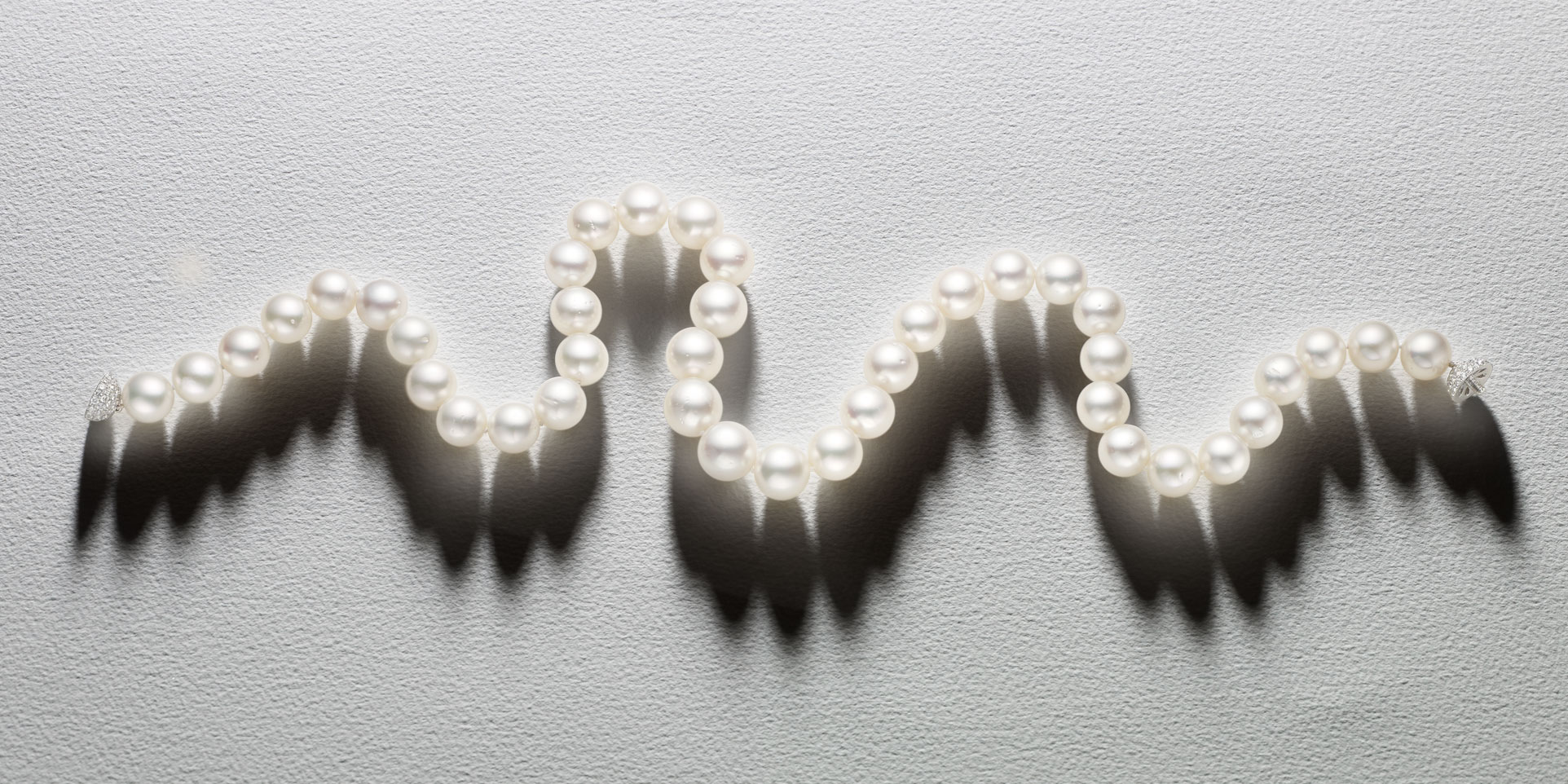
Image: A Winterson South Sea pearl and pave diamond clasp necklace
Their extravagant value lead to the pearl playing an important role in trade, which only increased once they were discovered in Central and South America in the 15th century, a discovery which led to the so called Pearl Age.
As a visible symbol of wealth, the demand for pearls escalated, particularly in Western Europe, where royals and aristocrats increasingly emulated their peers in China, India and the Arab states, commissioning elaborate pearl necklaces, earrings, bracelets and brooches.
By the 19th century, demand for pearl jewellery was so high that the supply of natural pearls began to dwindle to the point today where historic pieces of natural pearl jewellery are so rare they can fetch high six or seven figure sums at auction.
The Pearl Necklace
As a result of the way that they reflect light to the face, strands of pearls have become the most popular form of classic jewellery over the ages. The more strands in a necklace, the greater that the necklace reflected the wealth of its owner.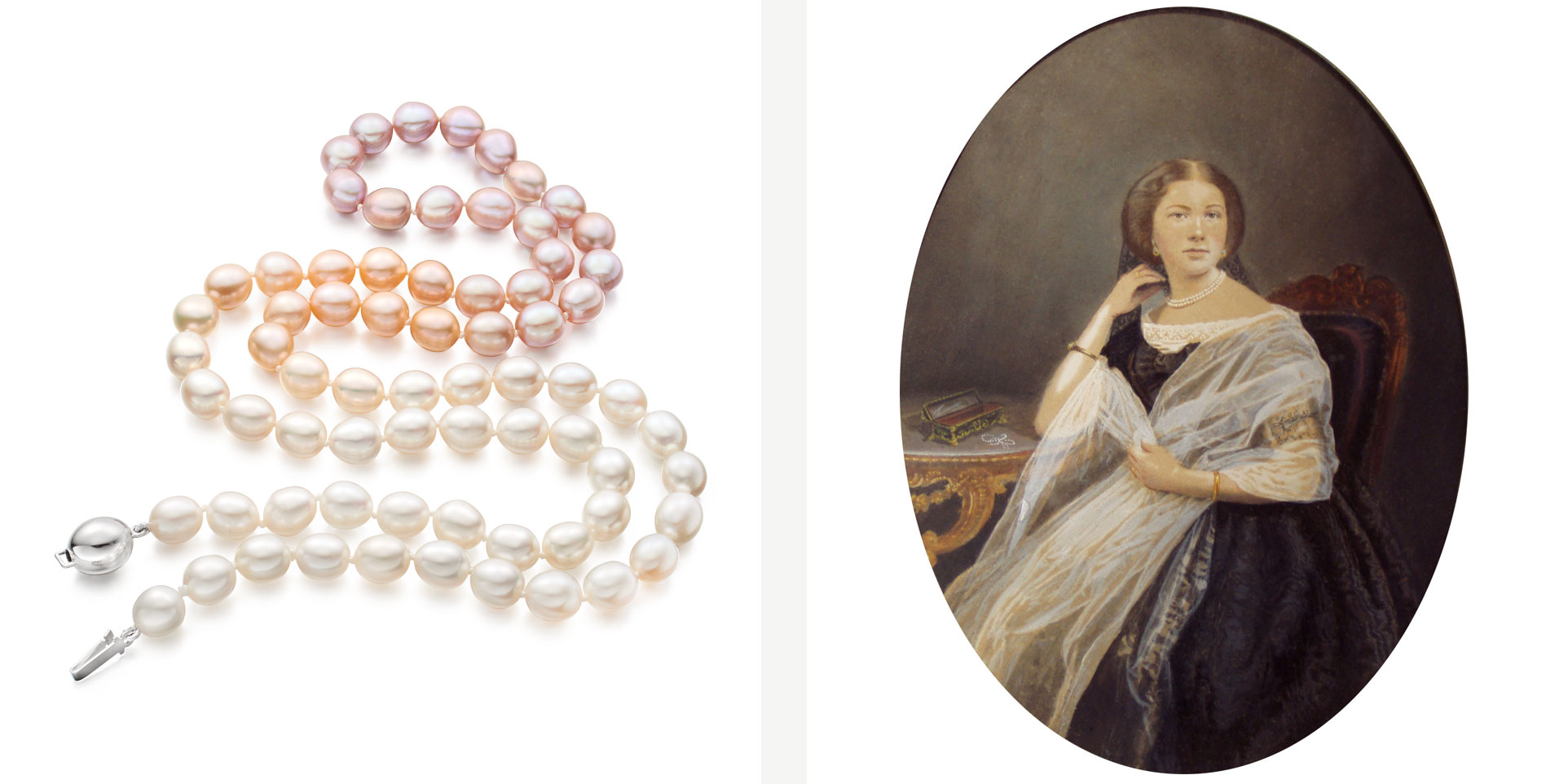
Image 1: Blush Sunrise Necklace
Image 2: A portrait miniature of Emma Ostaszewska née Countess Załuska, ca. 1850s
The lustre of the gems was often preserved by having Victorian maids wear the necklaces during the day to keep the pearls warm and radiant for their mistresses.
With the arrival of the cultured pearl, the status of the gem has shifted over the 20th century, becoming more widely accessible. The multi strand pearl necklace remains an enduring piece of classic jewellery that actresses, society ladies, designers and jewelers such as Winterson prize winner Bella Mung continue to revisit.
Our pearl specialists individually select and grade each strand that makes up a Winterson necklace, often viewing and reviewing pearls throughout the day to be aware of the impact of shifting light on the overtones and lustre of the pearl. Our necklaces are available in multiple lengths, colours, and different types of pearls, including Akoya, Freshwater, South Sea and Tahitian. Read our Buying Guide to choosing a necklace to learn more.
The Pearl Stud
After the pearl necklace, pearl studs form another cornerstone of a woman’s classic jewellery wardrobe. The legendary Coco Chanel was well known for her enduring love of these beautiful gems,which she wore prodigiously (real and fake together).
Although she favoured the monochrome white pearl necklace, once famously declaring “a woman needs ropes and ropes of pearls", her single pearl clip earrings were almost as significant a part of her iconic image.
Image 1: Pocket watch of gold, with enamel and oriental pearls, 1800
Image 2: Green Grey Tahitian Pearl Stud Earrings in Rose Gold
The pearl studs at Winterson are available in a wide choice of colours, sizes from 6-12mm , types of pearls and finished with 18 carat white, yellow and rose gold earring posts and butterflies.
The Pearl Drop Earring
In an era where natural pearls, with all their unique forms and qualities, were the stones that were used in classic jewellery, the popularity of the drop shape is unsurprising. Vermeer’s famous Girl with a Pearl Earring provides the archetypal blueprint for the freshwater drop earring, a classic style that has most recently been adopted by the current Duchess of Cambridge.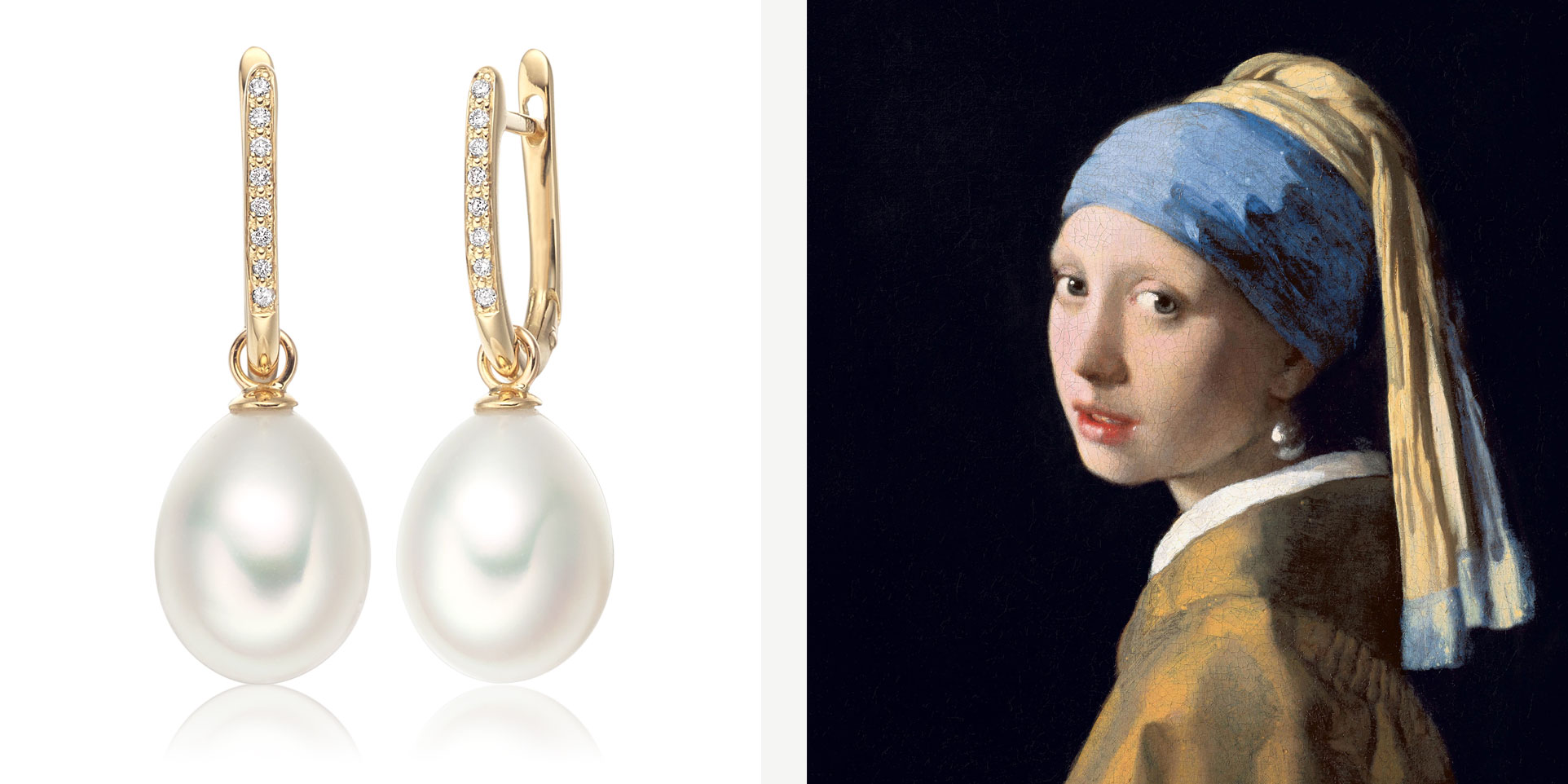
Image 1: Yellow Gold Diamond Leverback And Freshwater Pearl Drop Earrings
Image 2: The Girl With The Pearl Earring, Johannes Vermeer, 1665
Natural pearl drops continue to fetch high sums at auction, as the sale of a pair of earrings owned by Empress Eugenie of France, wife of Napoleon Bonaparte, amply demonstrated. Fetching $3.3 million, the drops were then promptly reset for their new owners by American high jeweler Lee Sieglson, reflecting that the value was paid for the pearls rather than their original setting.
The Seed Pearl Ring
Seed pearls gained popularity in Georgian and Victorian jewellery, where they often accented the frame of rings and earrings in the same way that diamond pave does today.
Image 1: Funeral Ring, Landscape and Temples, 18th Century
Image 2: Beau Seed Pearl and Enamel Ring with Yellow Gold
Often seen as part of mourning jewellery, set around painted portraits or landscapes or offset by washes of enamel, this era of jewellery formed the basis of inspiration for Alice Cicolini’s Beau collection for Winterson.
The Pearl Brooch
Seed pearl pave, where lines of these wonderful tiny pearls are set in single or multiple rows, also offered a stylish way for jewellers to incorporate the pearl in brooches. This form of jewellery became highly popular in the 19th century as a decorative jewel, rather than as a functional object which was the original purpose of the brooch.
Although their popularity has waxed and waned over the years, it appears as if the brooch may be increasing in popularity again as fashion brands and jewellers alike seek new surfaces for jewels to come alive.
Perhaps pearls may also find their way onto these new generation designs. The Duchess of Cambridge might have recently signalled the reinvention of this classic jewellery design at a recent state visit, wearing the Queen’s triple pearl and diamond leaf pearl brooch with the stunning Collingwood Pearl and Diamond drop earrings which she often favours. -
The spectacular rise and style of Rose Gold
The spectacular rise and style of Rose Gold
What do Apple, Birkenstock, Beats and Hervé Léger all have in common? They have all succumbed to the appeal of a material that jewelers have long celebrated – rose gold.
Now a major colour trend across homeware, technology and accessories, rose gold adorns products that are as diverse as Wet N Wild lip gloss and the iPhone. Recognising its popularity, in 2016 the Pantone Institute chose a blend of warm Rose Quartz with a more tranquil Serenity blue as its Colour of the Year, influencing product design and direction.
What is rose gold?
Rose gold is a composite gold alloy of 75% yellow gold, 22.25% copper and 2.75% silver. It finds its purest form as Crown Gold, a 22 carat mix of 91.667% yellow gold and 8.333% copper. This alloy has been used to mint British Sovereign coins since Henry VIII introduced it in 1526.

Image 1: Zigzag Diamond Pendant
Image 2: Pair of Zigzag Diamond Earrings with Akoya Pearls
Variations such as pink and red gold arise from modifications to the amount of copper and silver that are added to the mix, either amplifying or lightening the dusky rose tones.
What are its origins?
The history of rose gold also finds an echo in its last golden age: in Imperial Russia at the beginning of the twentieth century. Royal jeweler, Carl Fabergé, popularized the metal as a royal favourite, creating some of his most ornamental pieces in delicate blush tones.
Most famously, the “Moscow Kremlin” egg was commissioned by Emperor Nicholas II as a gift for his wife. The gold and white enamel egg was housed within a miniature replica of Red Square’s fifteenth century Spasskaya Tower and, at 11,800 rubles, was one of Fabergé’s highest value commissions.
Rose gold rising
Symbolism is undergoing a significant and seemingly unstoppable popular revival, particularly in jewellery. The emotional impact of its colour, with all its myriad interpretations and meaning, is widely studied by designers and marketeers alike.
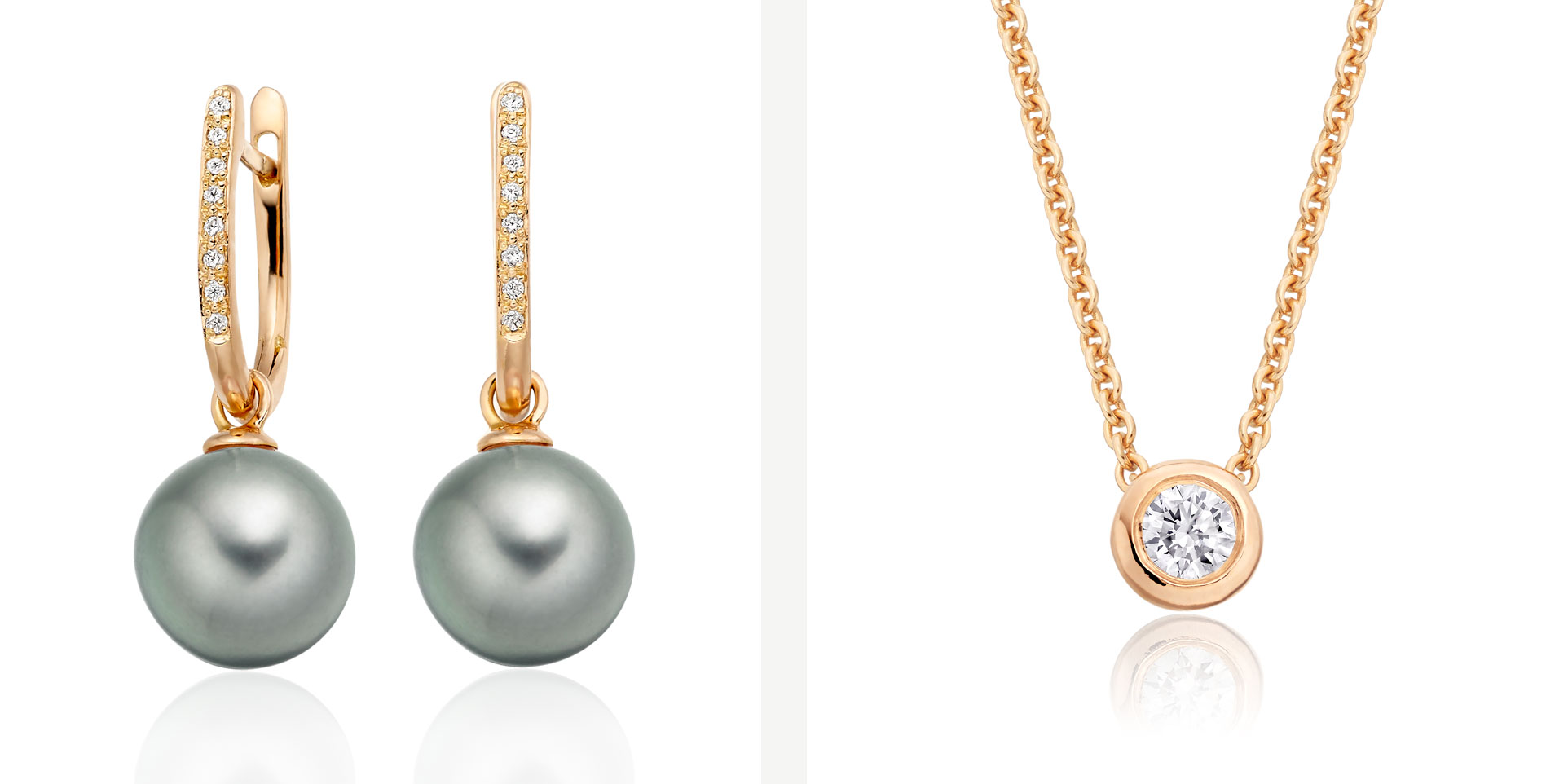
Image 1: Grey Tahitian Pearls with Diamond Leverback Earrings
Image 2: Classic 0.10ct Diamond Pendant
“When we get to the rose family,” says Leatrice Eiseman, the Pantone Institutes’ executive director, “we get ‘compassion, composure, warmth’, something that draws you in.”
One of the reasons for rose's popularity today is that, for consumer goods companies, this warmth has huge potential in attracting new customers. In growth markets such as China, the luxury connotations of gold and the “sense of mindfulness” that Eiseman identifies with its rose-hued cousin has significant appeal.
On trend for the autumn
In jewellery, Dior, Piaget and Van Cleef & Arpels have led the trend towards rose gold’s revival as a high jewellery material. Rose gold is a natural canvas for coloured stones, and brings delicacy as well as warmth to the traditional combination of white pearls with diamonds.
At Winterson, our Classics collection includes some of our most popular jewellery designs, that have been finished with 18 carat rose gold, white diamonds and pearls.
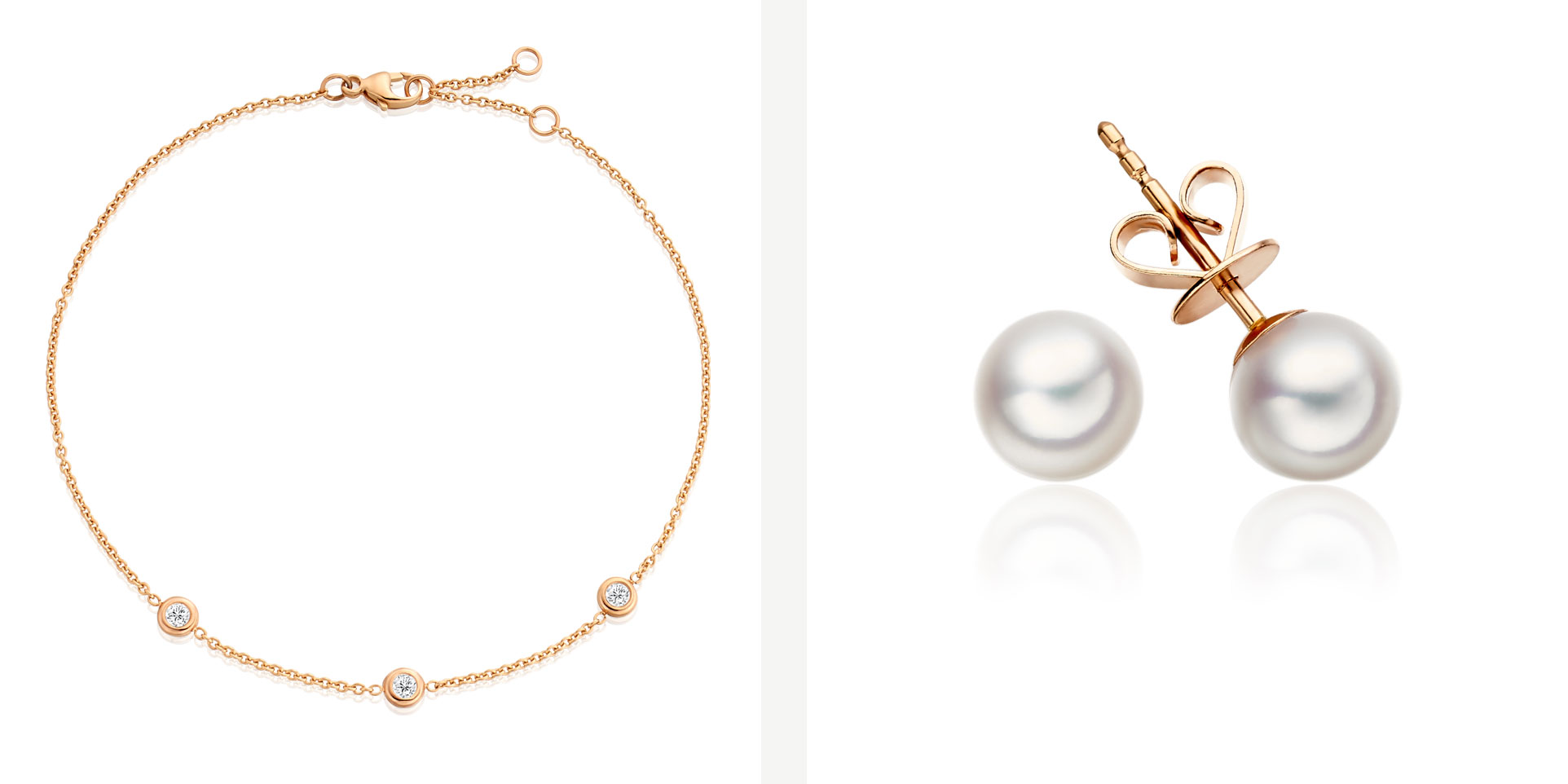
Image 1: Classic 0.12ct Diamond Bracelet
Image 2: Classic White Akoya Pearl Stud Earrings
There are many ways to wear this beautiful style of gold. We love the femininity of the rose gold and white diamonds of our new triple diamond bracelets and the elegant addition of light grey Tahitian pearls to our rose gold and diamond leverback earrings. The lovely combination of rose gold with the blush overtones of a white saltwater pearl in our Classic Akoya pearl studs might be the simplest and also the best.
Already a fan? Wholeheartedly embrace the trend with our striking Luna Moss ring in rose gold, green sapphire and a stunning peacock green Tahitian pearl. -
Balenciaga: Shaping Fashion at the V&A
Balenciaga: Shaping Fashion at the V&A
Extraordinary as it may seem, the V&A’s Balenciaga: Shaping Fashion, recently opened, is the first British exhibition to focus on the work of Cristobal Balenciaga, the 20th century master of couture described by Cecil Beaton as the “Picasso” of fashion.
“Underneath all his experiments with the modern,” Beaton wrote, “Balenciaga has a deep respect for tradition and a pure classic line.” It was Beaton who acquired what is now Britain’s largest collection of Balenciaga couture for the V&A in the 1970s. He was one of many admirers, from protégé Hugo de Givenchy to Coco Chanel, who believed that “Balenciaga alone is a couturier in the truest sense of the word.”

Image 1: Cristóbal Balenciaga at work, Paris, 1968.
Image 2: Evening dress, Cristóbal Balenciaga, Paris, 1962.
The exhibition focuses on Balenciaga ‘s couture techniques, as well as his approach to business and his international clientele, revealing the balance that he struck between tradition and modernity. Two inspired commissions “shed new light on his exquisite craftsmanship,” says V&A curator Cassie Davies-Strodder, “and challenge some of the myths that have built up around the elusive designer.”
One is a series of life-size x-ray images by artist Nick Veasey that reveal for the first time the underpinnings of some of Balenciaga’s most famous style innovations.

Image: Balenciaga Shaping Fashion Exhibition View
Focusing on the latter part of his career, the collection presents some of his most famous shapes, many of which caused consternation at the time but have gone on to form wardrobe staples for women for generations – “the tunic, sack, ‘baby-doll’ and shift dress all remain style staples today,” says Davies-Strodder. Sketches, animated patterns, fabric samples, photographs and catwalk images accompany the garments, giving a glimpse into the couturier’s “uncompromising creativity.”
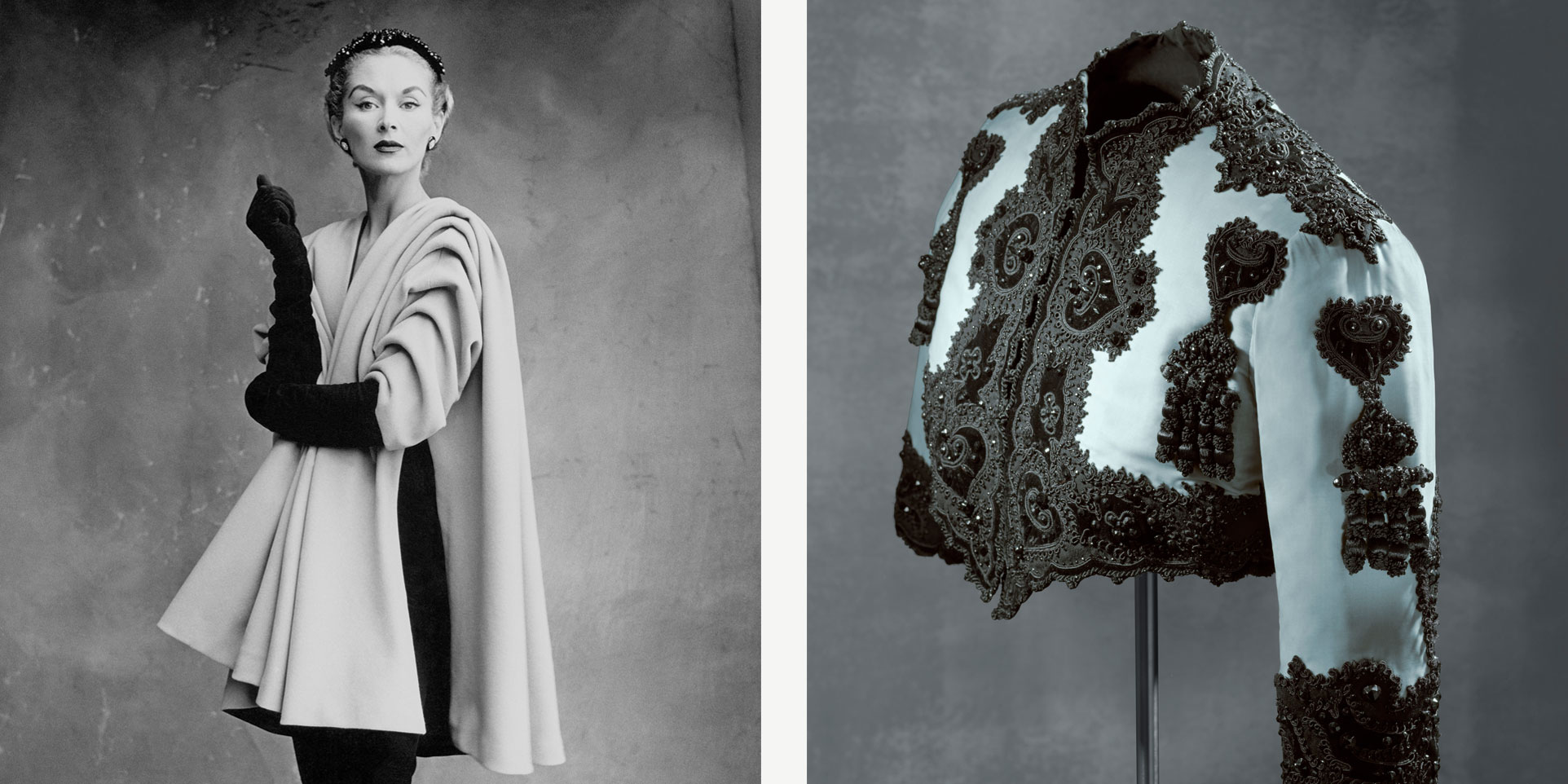
Image 1: Lisa Fonssagrives-Penn wearing coat by Cristóbal Balenciaga, Paris, 1950.
Image 2: Bolero jacket, EISA, Spain, 1947.
Alongside Veasey’s x-rays, they reveal Balenciaga to be deeply knowledgeable of his craft, inspired by sources as diverse as the structures of 18th century dress, the folds of the Roman toga and drape of the Japanese kimono. Balenciaga was able to innovate whilst at the same time using traditional boning structures, cutting techniques, metal weights and other sleight of hand to amplify the extraordinary silhouettes that had previously appeared to be created by genius alone.
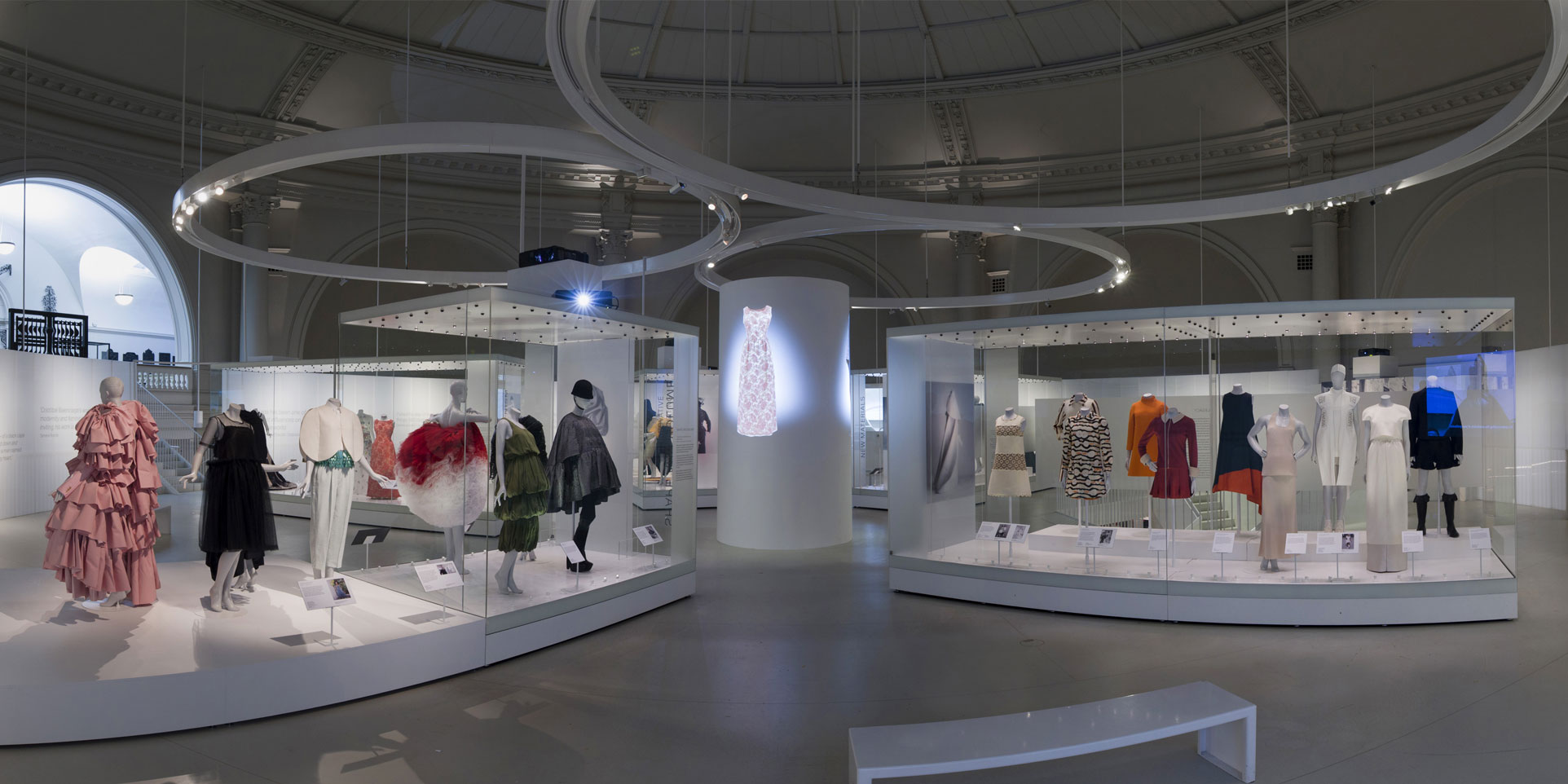
Image: Balenciaga Shaping Fashion Exhibition View
The exhibition marks the centenary of the opening of Balenciaga’s first fashion house in San Sebastian, and the 80th year since he founded his eponymous label in Paris. It opens with a series of pieces inspired by his native Spain, framing his explorations of colour, black lace, silhouette and drama as characteristically Mediterranean qualities.
Alongside his craftsmanship, it looks at the growth of the business, in particular how Balenciaga’s understanding of his client’s lives contributed to his success, inspiring key shapes and ideas. His love of the sleeve, particularly the bracelet shape and the kimono drape that became his signatures, was informed by the way these shapes helped to frame of his client’s jewellery. The standaway collar, another signature, was described as the best shape to emphasise the beauty of – of course – a string of pearls.
The exhibition runs until 18th February 2018, supported by a series of workshops and lunchtime lectures. Further details can be found on the V&A's website. -
Coline Assade, Winner of the Winterson Prize 2016
Coline Assade, Winner of the Winterson Prize 2016
Eclectic degree collections from jewellery design’s future stars went on display at Central Saint Martins last night (June 23rd), where Coline Assade was announced as the winner of the 2016 Winterson Prize for the Best Use of Pearls.
The influential arts institute’s annual graduate show saw students presenting original pearl pieces, created with advice and support from Winterson Director Andrew Fraser and Creative Director Alice Cicolini.
Coline was named this year’s winner of the prestigious pearl prize for her collection ‘Unconventional Femininity’, an exploration of identity and self-expression. Graduate Chlóe Valorso also received a special commendation from the judges for her work.

Each year we look for work that demonstrates an understanding and appreciation of the pearl and, with such a high standard on display this year, Coline was an excellent winner.
Coline described her collection to us: “My collection was about femininity and identity. I wanted people to be more playful with their identity and make them raise questions about what is gender and who they really are. I used the pearls as playful moving parts of the jewellery. On the ring there’s a contradiction between the very round and colourful shapes, so you can choose what you want to wear and what you want to hide.”
Commenting on the award, Winterson's Creative Director Alice Cicolini said "Coline embraced the pearl and put it at the heart of her collection, celebrating the uniqueness of the baroque pearl as a symbol of feminine individuality. We were impressed by her willingness to experiment and her bold, distinctive voice."
A throughly deserving winner for this year's prize, congratulations Coline!
Read more about Coline and the other CSM designers' work here.
-
How to Choose Pearls For Your Wedding Jewellery
How to Choose Pearls For Your Wedding Jewellery
The timeless beauty and versatility of pearls make them an ideal choice of wedding jewellery, with a classic style that can complement any dress.
Not only will you have a beautiful and wearable reminder of your big day, but as pearls photograph so well, you are guaranteed some incredible pictures to cherish too.
There are several factors you may wish to consider when selecting your pearls to ensure they provide the perfect finishing touch.
FIRST THINGS FIRST
Unless you have a heritage piece that you are determined to wear, it is best to select your dress and any headpiece or veil you might wear, before looking at your jewellery options.
As your dress should be the main event, a ‘less is more’ approach such as with a classic Akoya pearl necklace would be wise to follow when it comes to your jewels.

There are some simple rules that are best to keep in mind. If you are wearing an elaborate headpiece, you may need to forgo wearing a necklace. But if your dress has a simply cut style, then you can be a little more daring with your jewellery.
YOUR NECKLINE
Before deciding on the type of pearl to wear, you need to establish which pieces of jewellery will work best with your dress.
Sweetheart
A short pendant or string of pearls will complement a sweetheart neckline. And while there is plenty of bare skin to play with, it is best to avoid longer chains which may lessen the impact of this stunning bridal shape. Choose a necklace of between 42 and 45cm in length.
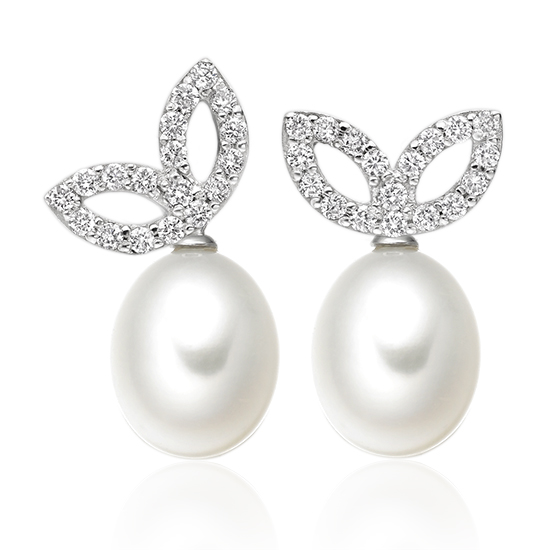
Combine with matching earrings, or if you decide against a necklace entirely, go for more striking statement pearls for your ears, such as the Lief Enchanted Earrings in White Gold and Freshwater Pearls, designed by Alice Cicolini.
Strapless
Arguably the most versatile of necklines, strapless dresses can carry almost any type of jewellery.
While you can keep things simple with a subtle pearl choker, this neckline also offer the opportunity to go for bolder earrings or a chunkier necklace.
V-neck
This neckline is perfect for pendants. Choosing a freshwater pearl combined with a diamond will see you exuding bridal chic.
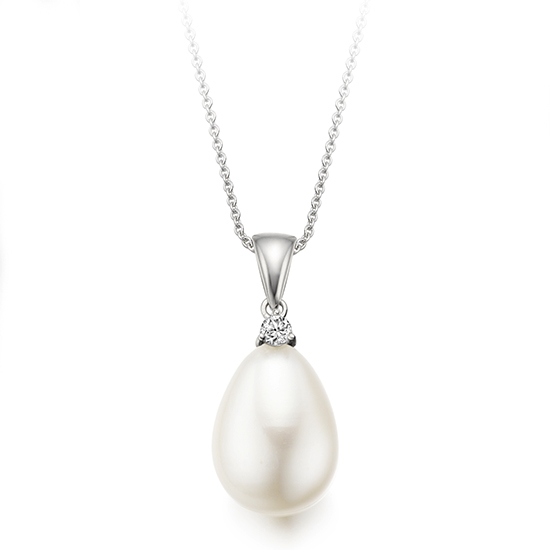
Alternatively, this shape also lends itself to the classic charm of a double strand or looped long pearl necklace.
CHOOSING THE TYPE OF PEARLS
It’s also important to consider the shade of your dress when choosing your gems.
Freshwater pearls are a dream match for ivory and cream wedding dresses, while Akoya pearls will complement a white gown.
Ivory and cream dresses can also be lifted by the golden tones of South Sea pearls.
MATCH YOUR METALS
If your dress is of a bright white hue there’s a chance gold embellishments will clash, so go for pearls set on white gold or platinum.
Off-whites work with both gold and silver tones, while gold jewellery can make the most of yellow undertones in ivory and cream gowns.
SOMETHING BLUE?
Depending on your colour scheme, your jewellery offers a perfect opportunity to elegantly work in your ‘something blue’.
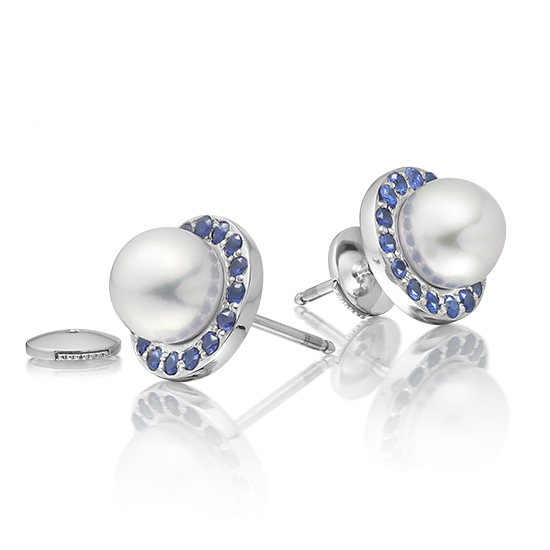
Blue Sapphire Stud Earrings in White Gold with Akoya Pearls offer the perfect lift to a stunning bright white dress, while Sophie Breitmeyer’s Blue Sapphire and Akoya Pearl Pendant could add an ideal modern twist to a vintage inspired dress.
Discover more about buying pearls and choosing jewellery by reading our expert guides, or view the wedding collection here.
-
Evangeline Armstrong, Winterson Prize 2015
Evangeline Armstrong, Winterson Prize 2015
We are delighted to announce that Evangeline Armstrong is the winner of this year's Winterson Prize for the Best Use of Pearls, for a witty and playful new collection of jewellery.
For the past three years we have been supporting the students of Central Saint Martins, the influential London arts institute, with pearls and advice on working with this beautiful gem.
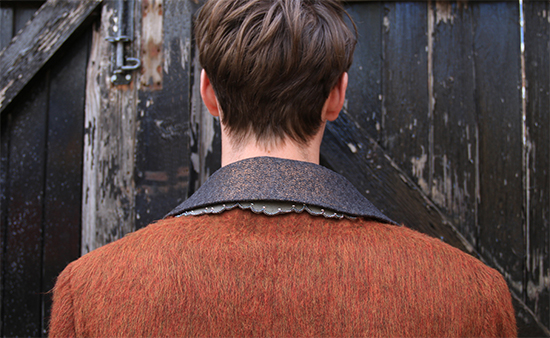
Every year a number of students choose pearls as the main focus for their degree show collection and this year’s candidates did not disappoint with their work, delivering an impressive array of imaginative design.
The result was an exciting and varied portfolio of exquisite pieces, ranging from the classic through to the more avant-garde.
The annual BA Jewellery Design Awards took place on Thursday 25th June at an exclusive ceremony at Central Saint Martins, London.
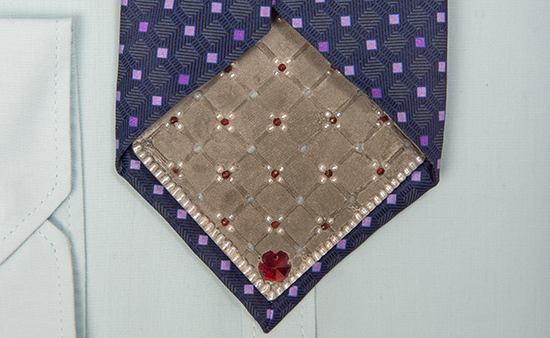
Joining Andrew Fraser from Winterson on a panel of leading jewellery design experts was Caroline Broadhead, Programme Director at CSM, Maia Adams, Director and Founder at Adorn Insight, and British jewellery designer and Creative Director of Winterson, Alice Cicolini, herself an MA graduate of Central Saint Martins.
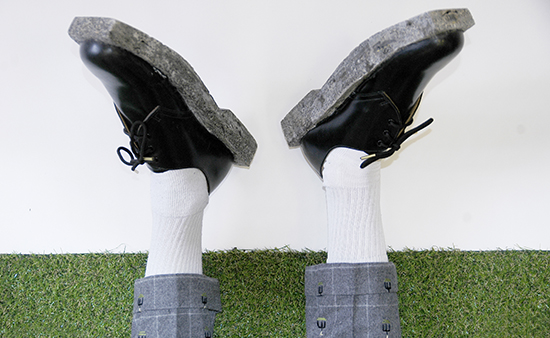
Titled ‘The Daily Grind: Secret Jewellery For the City Businessman’, we loved the modern approach taken by Evangeline. Setting classic pearls in concrete, with tailored men's fashion, fully reflected the fun and expression of the story behind the jewellery.
Commenting on the views of the judges, our Creative Director Alice Cicolini said: “We were intrigued by the whole concept of making these extremely beautiful flashes of subtle classicism appear from underneath the very conservative style of men’s shirts and suits"
A great winner for this year’s prize and congratulations to Evangeline!
Watch the video above or here. To learn more about this year's competition, read the first part in our series of interviews with Evangeline Armstrong and the students at CSM.
-
Jewellery Trends Summer 2015 - Colour, Chokers and Pearls…
Jewellery Trends Summer 2015 - Colour, Chokers and Pearls…
As summer arrives, all those emerging jewellery trends that we spotted on the SS15 catwalks will start to feature high on wish lists and influence our shopping habits.
Delicately enhancing the estate jewellery seen at shows by Prada and Dolce and Gabbana, and appearing on exquisite chokers by Lanvin and Chanel, pearls look set to be a major jewellery trend again this season.
And if you have a long established desire to own some truly beautiful jewellery, now is the ideal time to consider how you would like to wear your pearls.
THE HERO PEARL
For some, pearl jewellery will mean a classic strand of pearls. Unquestionably beautiful and effortlessly elegant, a classic strand will always stand the test of time. But it is the exquisite lustre of the pearl, arguably one of nature’s most beautiful gems, that’s inspiring a whole new wave of designers to work with it.

With any ‘hero’ pearl piece, simplicity is key. One unique pearl takes centre stage and makes its statement.
Single pearls on gold bands, worn stacked or with multiple rings across fingers will be a particularly popular way to embrace this particular trend.
ESTATE JEWELLERY
Estate jewellery describes those antique and vintage pieces that also featured in many of the new season’s shows.
Delicate Georgian earrings adorned the ears of catwalk models in all shapes and sizes.
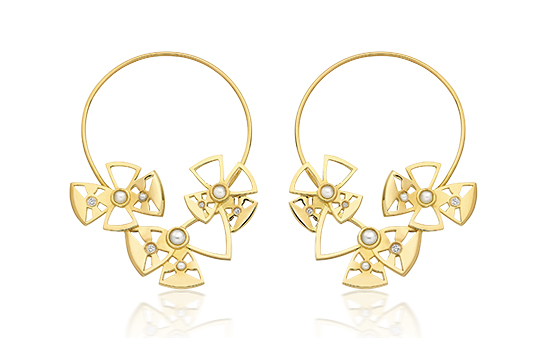
Winterson Creative Director Alice Cicolini’s 19th century inspired Beau collection takes inspiration from this quintessentially British style. Centering her designs around a modern bow pattern, she plays with the language of lustrous seed pearls, diamonds and enamelling to exquisite effect.
CHOKERS
While we saw statement, at times more flamboyant, pearl chokers from Lanvin, there were also more wearable influences taking centre stage such as those from Coach.
For anyone feeling unsure about embracing such a stand-out trend, a simple, classic pearl strand could be the perfect entry point.
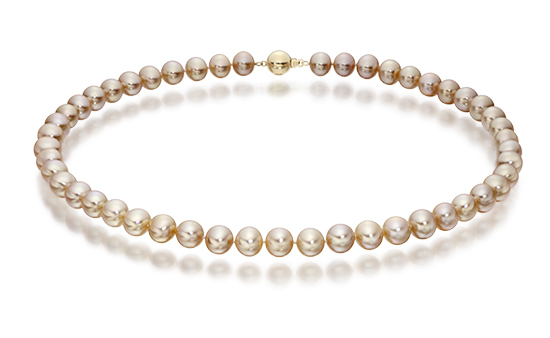
Pink Freshwater or peacock green Tahitian pearls can offer an extra colour dimension to any pearl jewellery, while pure white Akoya pearls ensure that you will be able to match your new piece to almost any outfit.
RAINBOW GEMSTONES
A cascade of colour dazzled us at SS15 shows worldwide, a particular highlight for colour-lovers being Ralph Lauren’s vivid rainbow-coloured display of gemstones.
This eye-catching trend for rainbow gems looks set to stay for summer. And with such a range of colours out there, it is just a question of deciding how bright you would like to go.
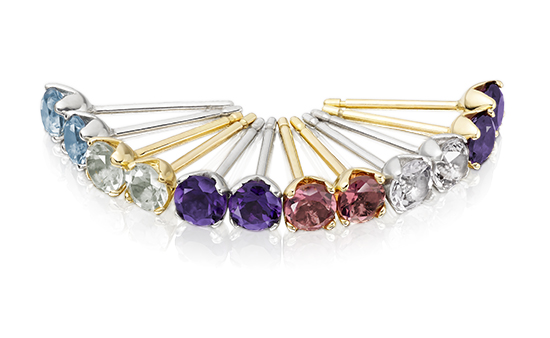
Bright amethyst or blush pink tourmaline alongside pearls or diamonds are a failsafe option if you want to stay classic.
Delicate gemstone studs also embrace another current trend for mismatched or unbalanced earrings. Mix and match them and have some fun experimenting as you go.
TAHITIAN PEARLS
While some of the major design houses remain fixed on the trend for classic white pearls with yellow gold, many others showcased the Tahitian pearl.
Often known as black pearls, these gems can range from light grey to a vivid peacock green in colour, making them an eye-catching accessory to any outfit.

Winterson’s Luna Rose ring combines a striking aubergine Tahitian pearl with yellow gold and a pink sapphire, while the different tones in our Multi-coloured Tahitian Pearl Necklace reveal the true wonder of French Polynesia’s treasure gem.
-
Savage Beauty: Alexander McQueen
Savage Beauty: Alexander McQueen
Two current exhibitions in London reverentially showcase the work and career of Alexander McQueen (1969-2010), one of fashion's most innovative designers.
Alexander McQueen: Savage Beauty at the V&A and Nick Waplington/Alexander McQueen: Working Process at Tate Britain offer different perspectives on the late designer's talent, influences and processes.

First shown in New York and extended here at the V&A, Savage Beauty is a wonder, a series of rooms filled with gothic fantasy, tribal identity, romantic inspiration and a passion for nature.
The exhibition is structured as a narrative of different collections, starting with McQueen's tailored and revealing bumster trousers, his 1995 Highland Rape collection, 1996's Hunger and the exhilarating Horn of Plenty from 2009.
The exhibition finale recreates 2010's Plato's Atlantis collection, a futuristic and thrilling fusion of technology and fashion, complete with its famous Armadillo shoes.

Deeper within the exhibition is the dramatically macabre Cabinet of Curiosities.
This centrepiece room is a spectacular double-height gallery showing archive video footage from McQueen's catwalk shows and accessories, including a butterfly headdress of hand-painted turkey feathers (pictured above) by milliner Philip Treacey.
Jewellers Sarah Harmarnee and Shaun Leane feature prominently. Leane was a long-time collaborator of McQueen, having first met at Central Saint Martins in London.
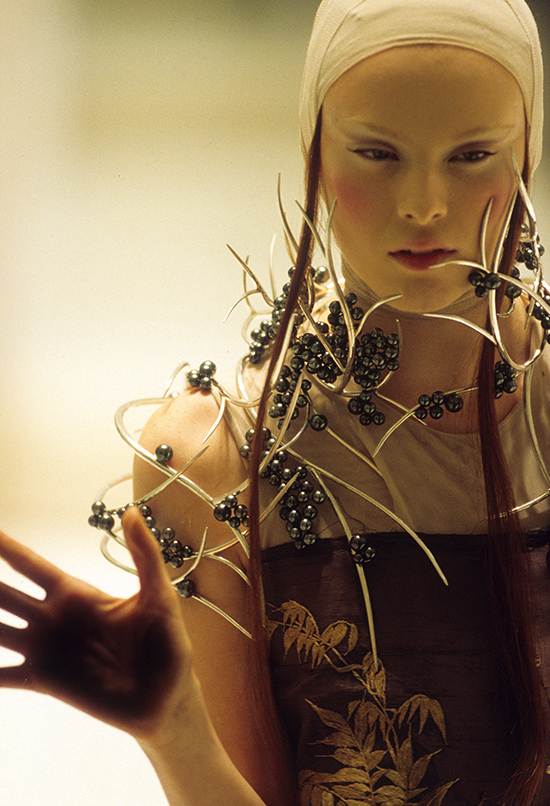
Leane's distinctive aesthetic is recognisable in the pieces shown in the Cabinet - a Tusk earring for McQueen's Hunger S/S 1996 collection and this neckpiece (pictured above) with silver thorns and grey Tahitian pearls from 2001.

Performance and footage from McQueen's shows feature throughout the exhibition, with one highlight being a hologram of Kate Moss floating eerily in the finale to the 2006 Widows of Culloden show.
The staging of the exhibition has been beautifully done with many pieces such as the razor clam dress (pictured above), arguably being close to works of art themselves.
A must-see retrospective, this exhibition gives a glimpse of the extraordinary and creative talent at work.
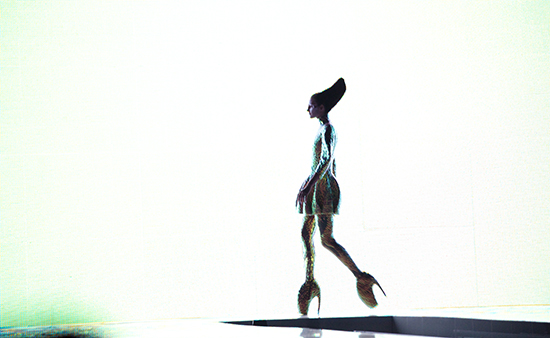
On McQueen's right arm was a tattoo, with words from A Midsummer Night's Dream 'Love looks not with the eyes, but with the mind'.
If you are left wanting more, it would be to understand and hear from McQueen himself.
Savage Beauty is open at the V&A, London until 2 August 2015.